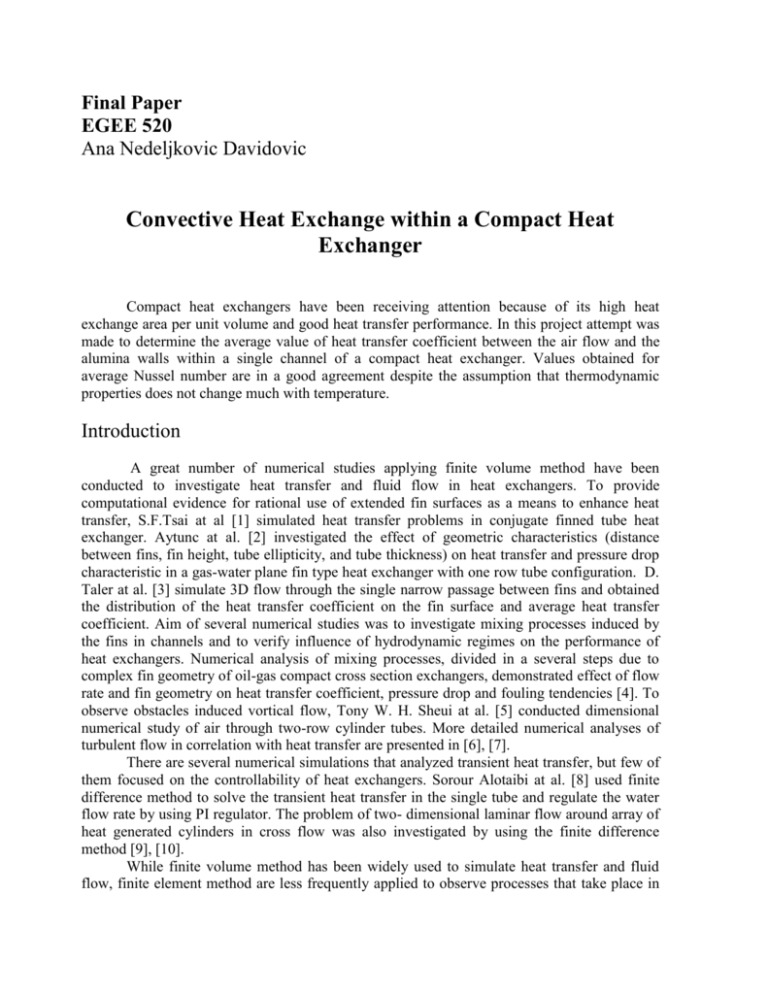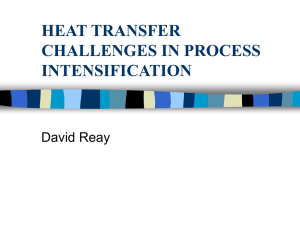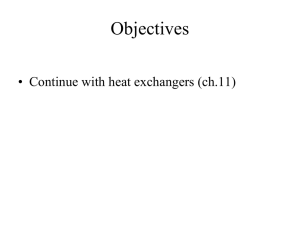Final_Paper_ana
advertisement

Final Paper EGEE 520 Ana Nedeljkovic Davidovic Convective Heat Exchange within a Compact Heat Exchanger Compact heat exchangers have been receiving attention because of its high heat exchange area per unit volume and good heat transfer performance. In this project attempt was made to determine the average value of heat transfer coefficient between the air flow and the alumina walls within a single channel of a compact heat exchanger. Values obtained for average Nussel number are in a good agreement despite the assumption that thermodynamic properties does not change much with temperature. Introduction A great number of numerical studies applying finite volume method have been conducted to investigate heat transfer and fluid flow in heat exchangers. To provide computational evidence for rational use of extended fin surfaces as a means to enhance heat transfer, S.F.Tsai at al [1] simulated heat transfer problems in conjugate finned tube heat exchanger. Aytunc at al. [2] investigated the effect of geometric characteristics (distance between fins, fin height, tube ellipticity, and tube thickness) on heat transfer and pressure drop characteristic in a gas-water plane fin type heat exchanger with one row tube configuration. D. Taler at al. [3] simulate 3D flow through the single narrow passage between fins and obtained the distribution of the heat transfer coefficient on the fin surface and average heat transfer coefficient. Aim of several numerical studies was to investigate mixing processes induced by the fins in channels and to verify influence of hydrodynamic regimes on the performance of heat exchangers. Numerical analysis of mixing processes, divided in a several steps due to complex fin geometry of oil-gas compact cross section exchangers, demonstrated effect of flow rate and fin geometry on heat transfer coefficient, pressure drop and fouling tendencies [4]. To observe obstacles induced vortical flow, Tony W. H. Sheui at al. [5] conducted dimensional numerical study of air through two-row cylinder tubes. More detailed numerical analyses of turbulent flow in correlation with heat transfer are presented in [6], [7]. There are several numerical simulations that analyzed transient heat transfer, but few of them focused on the controllability of heat exchangers. Sorour Alotaibi at al. [8] used finite difference method to solve the transient heat transfer in the single tube and regulate the water flow rate by using PI regulator. The problem of two- dimensional laminar flow around array of heat generated cylinders in cross flow was also investigated by using the finite difference method [9], [10]. While finite volume method has been widely used to simulate heat transfer and fluid flow, finite element method are less frequently applied to observe processes that take place in heat exchangers. C. G. du Toit determined wall sheer stresses and heat flux at a wall of a rectangular duct [11]. Subjecting equations to Dirichlet boundary condition and assuming fully developed laminar flow as well as uniform wall heat flux C. G. du Toit significantly simplified the problem. P. Nithiarasu proposed locally conservative Galerkin finite-element approach for one–dimensional transient heat conduction and two dimensional convection-diffusion problems [12]. Similar problems as in [2] but with numerical technique based on finite element method were investigated in [13], [14]. To handle velocity-pressure coupling G. Comini and G. Croce applied procedures that share some features with SIMPLE method [14]. Numerical analyses proved that thermal performance of a heat exchanger may be significantly dependant on longitudinal heat conduction. To take into account effects of wall longitudinal heat conduction the equations are developed as coupled convection-conduction problem [15]. Convectionconduction analysis of heat exchangers is further extended by developing mathematical equation to simulate flow non-uniformity [16], [17]. In addition to many publication on this topic, there are several books available that provide excellent information on finite element method with accent on heat and fluid flow [18],[19],[20], [21]. The objective of this project was to determine temperature and velocity field within a section of the heat exchanger, and to calculate the average value of the heat transfer coefficient from the working fluid to the wall of the heat exchanger. The study was divided in two parts: 1. Heat transfer within a single channel; 2. Heat transfer within a vertical multi-channel section. A model of a parallel -flow heat exchanger is presented in Figure 1. air 10mm 2 mm Figure 1: A model of a gas-gas parallel-flow heat exchanger Governing Equations First approach in this study was to solve simultaneously Navier –Stokes equation, continuity equation, and energy balance equation in order to determine temperature distribution, velocity distribution, and pressure drop. In order to simplify the model several assumption were adopted: - Laminar flow is fully developed; - Working fluids are incompressible; - Steady state conditions (the transient term on the left side of the equation was eliminated) 1) Navier –Stokes equation ( u ) - ((u + (u) T)) + ρ (u) u+p= F t 2) Continuity equation ( ρ u ) =0 3) Energy balance equation T ρ Cp + (-kT+ ρCpTu)= Q t (1) (2) (3) In this model the source term in the energy equation is zero. In order to solve temperature and velocity field several boundary condition were defined. 1) 2) 3) 4) 5) 6) 7) 8) T=Tcold, T=Thot at the inlet of the basic element; q*n=(-kT+ ρCpTu)=0 for symmetric condition or insulation; q*n= ρCpTu at the outlets (where all energy passes through the wall by convection); uz = 0; ux=0 for both fluids u=0 in the solid part of the heat exchanger; u*n=u0 inflow boundary condition; u*n=0 slip/symmetry boundary condition (where there is no velocity perpendicular to a boundary ); 9) u=0 no-slip (eliminates all component of the velocity vector); 10) p=p0 at the outlet of the element; However, attempt to couple Navier –Stokes equation and energy balance equation was not successful. The magnitude of order of characteristic fluid velocities in a heat exchanger is 1-10 m/s which results in a very high Peclet number. This is probably main reason why solution could not converge even after many change both in velocities and thermodynamic properties of fluids. To obtain stable model Navier –Stokes equation was replaced with the following analytical expression describing parabolic velocity distribution for square cross-section. u=16Umax(y-y0) (y1-y) (x-x0) (x1-x0) / [(y1-y0)2(x1-x0)2] (4) Parameters in the analytical expression for the stream velocity are determined based on the cross section position in the xy coordinate system. Table1: Analytical expression parameters x0 x1 y0 y1 0.001 0.0019 0.001 0.0019 Solution using FEMLAB FEMLAB heat transfer application mode is applied in the analysis of heat convection and conductance within a single channel. Dimension of a square cross section channel are 2mm x 2mm x 100mm with wall thickness of 0.1 mm. In order to solve equations and obtain the stationary analysis of the model Stationary nonlinear solver and Lagrange – Quadratic element type are used Figure 2: 3D temperature distribution in a single channel For the air stream and alumina the following thermodynamic characteristics are adopted. Air: k=0.0505 (w/m K) - thermal conductivity; c= 1529 (J/kg K) – specific heat capacity; ρ= 0.8824 (kg/m3) – density; W max = 1.4 (m/s) – velocity. Alumina: k=155 (w/m K) - thermal conductivity c= 895 (J/kg K) – specific heat capacity; ρ= 2730 (kg/m3) – density; Maximum velocity for which the model gave the stable solution was of 2.2 m/s. For faster air stream FEMLAB solution could not converge. Thermodynamic properties of the air and alumina are assumed to be constant and are adopted for mean temperature of the air and alumina. While properties of the air and alumina do not differ much from real values, the air velocity of 2.2 m/s is lower by 50-100% that gas velocity common for this type of heat exchangers. The following boundary conditions are adopted for the channel geometry. Wall surfaces: Twall= 500 K; Inlet and outlet wall surfaces: Thermal insulation; Channel inlet: Tinlet=300 K; Channel outlet: Convective flow. As expected, a distinct temperature gradient is obtained across the square cross section of the channel and downstream the channel. For maximum velocity W max =1.4 m/s, temperature changes significantly downstream and in a relatively short distance. With increasing maximum velocity to 2.2 m/s temperature gradient intensity decreases. Temperature distribution in the cross section and downstream for W max =1.4 m/s, Tinlet= 300 K, and Twall=500 K is presented in Figure 3 and Figure 4 respectively. Parabolic velocity distribution is presented in Figure5. Figure 3: Temperature profile (cross-section xy, z =0.5 l) Figure 4: Temperature profile (cross-section x z, x = d/2) Figure 5: Velocity profile (cross-section yz, y = d/2) Figure 6: 3D temperature distribution in a single channel In order to observe the effect of the adjacent channels within the counter-flow heat exchanger, another simulation is run (Figure 6). Boundary condition for the left and right wall surfaces are selected to be thermal insulation. Results obtained indicate that the temperature distribution within the wall changes significantly only in the inlet region within the distance of 0.25 mm. This can be explained by high thermal conductivity of the alumina wall. Validation using FEMLAB Flows in devices with characteristic dimensions of less than 1mm in size are called flows in micro-channels [21], [22]. Reducing characteristic length from 1 mm to 1 μm gases may enter the region where continuum mechanics approach cannot be applied. In our case, the channel external dimensions are 2mm x 2mm x 10 mm and the flow still can be considered as continuum. Literature [23] provides data for Nusselt numbers for fully developed laminar flow in ducts of various cross sections. Simplified procedure is conducted to calculate the average value of the Nusselt number for the single channel with constant axial wall temperature Twall=500 [K] and inlet air temperature T1=300[K]. Dimensions of the channel square cross section: δ= 1.8 [mm], L=10 [mm]. Velocity: Wmax= 2.2 [m/s]. Average temperature and velocity values are obtained by applying boundary integration for outlet cross section: FEMLAB results: ∫TodA=0.001528 [Km2] ∫WdA=3.168e-6 [m/s m2] Calculated values: To= 471.6[K] Wav=0.98 [m/s] Tmean inlet Reynolds number value corresponds to laminar flow. Remax= 68 2300 Mass flow rate: m A W =2.79e-6 [kg/m3] Amount of heat transferred to the fluid: Q m c p To Tinlet = 733.5e-3 [W] Average heat transfer coefficient: 1 Q 89.21 [W/m2K A Twall Tmean Average value of the Nusellt number: Nu=D/k Nu=3.18 The calculated value Nu =3.18 is in relatively good agreement with Nu= 2.976 provided by [21]. It should be noted that Nusselt number Nu=2.976 is derived for thermally fully developed flow with constant wall temperature on the boundaries. However, simulated results do not fully satisfy criterion for fully thermally developed flow. Nevertheless, performed simplified calculation confirmed the magnitude of order of Nusselt number and could be used as first approach to validate the numerical results. Housen recommended the value of Nusselt number for thermally developing, hydraulically developed flow for Re <2300 and constant wall temperature. As simulated air flow in the channel in this study can be considered thermally developing rather than fully developed, Housen equation presents more valid source of information for comparison purpose. Housen equation: D 0.8 ) L Nu 3.657 3.65 D 0.467 1 0.117(Re Pr ) L Our results Nu= 3.18 seems to be in good agreement with those found by applying Housen equation. 0.19(Re Pr Parametric study The objective of this parametric study was to determine: a) Flow velocity impact on convective heat transfer within single channel; b) Wall temperature impact on convective heat transfer within single channel; Calculation of the heat transfer coefficient is performed following the procedure explained in the validation part of the project. W [m /s] - Flow velocity; A [m2 ]- Cross section area of the channel; A [m2 ]- Total surface area of the channel; Tw [K] - Wall temperature; Tin [K] – Mean air temperature in the inlet cross section; To [K] – Mean air temperature in the outlet cross section; Tm [K] = in- Mean air temperature FEMLAB results: ∫TodA [Km2] ∫WdA [m/s m2] Mass flow rate: m A W Amount of heat transferred to the fluid: Q m c p To Tin Average heat transfer coefficient: 1 Q Ao Tw Tm Thermodynamic properties of the air are adopted for the T= 400 [K]. This assumption will probably not yield a great error in a case a) where mean temperature changes in the relatively narrow range 385-392 [K]. However, in the case b) where temperature of the air changes significantly 345-480[K] inaccuracy is larger. a) Flow velocity as a parameter of interest Table1: Parametric study with variable velocity v A Tw Tin To A [m2] [m/s] 2.2 2 1.8 1.6 1.4 3.24E-06 3.24E-06 3.24E-06 3.24E-06 3.24E-06 [K] 500 500 500 500 500 [K] 300 300 300 300 300 mass flow Tm Ao [kg/m3] 2.8E-06 2.54E-06 2.29E-06 2.03E-06 1.78E-06 [K] 385.8025 387.6543 389.5062 391.358 392.4383 [m2] 0.000072 0.000072 0.000072 0.000072 0.000072 To [Km2] 0.001528 0.00154 0.001552 0.001564 0.001571 c [W/kg K] 1529 1529 1529 1529 1529 VA [K] 471.6049 475.3086 479.0123 482.716 484.8765 density m2] [m/s 3.168E-06 2.88E-06 2.592E-06 2.304E-06 2.016E-06 Q hot [W] 0.733479 0.681191 0.626024 0.567979 0.502858 [W/m2K] 89.20696 84.21315 78.69016 72.61093 64.93144 [kg/m3] 0.8824 0.8824 0.8824 0.8824 0.8824 Calculations have confirmed that heat transfer coefficient decreases with decreasing flow velocity. Heat transfer between the air of lower mass flow rate and the wall of the unchanged temperature results in the higher gas temperature in the outlet cross section. b) Wall temperature as a parameter of interest Table2: Parametric study with variable wall temperature v A Tw Tin To A [m/s] 2 2 2 2 [m2] 3.24E-06 3.24E-06 3.24E-06 3.24E-06 [K] 400 500 600 700 [K] 300 300 300 300 [Km2] 0.001252 0.00154 0.00183 0.00213 To [K] 386.4198 475.3086 564.8148 657.4074 vA m2] [m/s 2.88E-06 2.88E-06 2.88E-06 2.88E-06 density [kg/m3] 0.8824 0.8824 0.8824 0.8824 mass flow [kg/m3] 2.54E-06 2.54E-06 2.54E-06 2.54E-06 Tm Ao [K] 343.2099 387.6543 432.4074 478.7037 [m2] 0.000072 0.000072 0.000072 0.000072 c [W/kg K] 1529 1529 1529 1529 Q [W] 0.335798 0.681191 1.028982 1.388766 hot [W/m2K] 82.12458 84.21315 85.27475 87.16104 Calculations showed that heat transfer coefficient increases slightly with increasing wall temperature. As expected, air temperature in the outlet cross section increases significantly. Multi-channel section of a heat exchanger To solve the model presented in Figure 7 the same equation and boundary condition as in a single channel model were used. The only exception is the boundary condition for the walls which are thermal insulation. It can be confirmed from temperature distribution within the heat exchanger section that compact heat exchangers have a great heat exchange performance. Due to high conductivity of the alumina wall cold fluid is heated almost equally from four surrounding walls. However, assumption that conductivity, specific heat, and density are constant affected the temperature distribution. Significant improvement of the model can probably be achieved by introducing polynomial fits for thermodynamic properties. With thermodynamic properties as a function of temperature we could expect lower heat exchange from vertical walls compared to horizontal ones. Figure 7: Temperature field in a heat exchanger section (T hot=700 [K], T cold=300K, v = 1.2 m/s) Conclusion According to the presented results we can conclude: - Nusselt number calculated using FEMLAB results and the simplified procedure has value 3.18w/m2K. This value is in a satisfactory agreement with those obtained from literature. In order to determine more accurately Nu, it is necessary to calculate local values of dimensionless heat transfer coefficient which requires more complex analysis of temperature field within the channel. -Heat transfer coefficient increases both with air flow velocity and the wall temperature. However, the heat transfer coefficient change with the wall temperature change should be taken with caution because of the assumption that thermodynamic properties are constant. -Main disadvantage of the model is the failure to implement Navier –Stokes equation into model. -To improve the existing model, it is necessary to implement the temperature dependence of thermodynamic air properties both in model and parametric study. Cp = a1 + a2T+a3T2+a4T3+a5T4 References [1]. S.F. Tsai, T.W.H. Sheu, S.M. Lee, Heat transfer in a conjugate heat exchanger with a wavy surface, International Journal of Heat and Mass Transfer 42 (1999) 1735-1745. [2]. Aytunc¸ Erek, Barıs Ozerdem, Levent Bilir , Zafer Ilken , Effect of geometrical parameters on heat transfer and pressure drop characteristics of plate fin and tube heat exchangers, Applied Thermal Engineering 25 (2005) 2421–2431 [3] D. Taler, Determination of heat transfer correlations for plate-fin-and-tube heat exchangers, Heat and Mass Transfer 40 (2004) 809–822. [4] E. Carluccio, G. Starace , A. Ficarella, D. Laforgia, Numerical analysis of a crossflow compact heat exchanger for vehicle applications, Applied Thermal Engineering 25, (2005) 1995–2013. [5] Tony W. H. Sheui, S. F. Tsai, and T. P. Chiang, Numerical Study of Heat Transfer in Two-Row Heat Exchangers Having Extended Fin Surface, Numerical Heat Transfer, Part A, 35:797 - 814, 1999 [6] M. Yaghoubi, M. Rahnema, Numerical study of turbulent flow and heat transfer from an array of thick plates, International Journal of Thermal. Science, (2000) 39, 213–224. [7] Yong-Jun Jang, Hamn-Ching Chen, Je-Chin Han, Computation of Flow and Heat Transfer in Two-Pass Channels with 60 deg Ribs [8] Sorour Alotaibi, Mihir Sen, Bill Goodwine, and K. T. Yang, Numerical Simulation of the Thermal Control of Heat Exchanger Numerical Heat Transfer, Part A, 41: 229- 244, 2002. [9] M. Wang and J. G. Georgiadis, Conjugate forced convection in cross flow over a cylinder array with volumetric heating, International Journal of Heat Mass Transfer. Vol. 39, No. 7, pp.1351-1361, 1996 [10] Jiin-Yun Jang and Mu-Cheng Wu, Numerical and experimental studies of three dimensional plate-fin and tube heat exchangers, International Journal of Heat Mass Transfer. Vol. 39, No. 14, pp. 3057 3066, 1996 [11] C. G. du Toit, Calculation of Friction Factors and Nusselt Numbers for Laminar Flow in Regular Ducts Using Finite Elements, Numerical Heat Transfer, Part B, 41: 397-407, 2002. [12] P. Nithiarasu, A Simple Locally Conservative Galercin (LCG) Finite-Element Method for Transient Conservation Equation, Numerical Heat Transfer, Part B, 46: 357–370, 2004 [13] Ricardo Romero-Mendez, Mihir Sen, K.T. Yang, Rodney McClain, Effect of spacing on convection in a plate fin and tube heat exchanger, International Journal of Heat and Mass Transfer 43 (2000) 39-51. [14]G. Comini and G. Croce, Convective Heat and Mass Transfer in Tube-Fin Exchangers Under Dehumidifying Conditions, Numerical Heat Transfer, Part A, 40: 579-599, 2001. [15] Ch. Ranganayakulu, K. N. Seetharamu, K. V. Sreevatsan, The effects of longitudinal heat conduction in compact plate-fin and tube-fin heat exchangers using a finite element method, International Journal of Heat Mass Transfer., Vol.40, No. 6, pp. 1261 -1277, 1997. [16] Ch. Ranganayakulu, K. N. Seetharamu, K. V. Sreevatsan, The effects of inlet fluid flow nonuniformity on thermal performance and pressure drops in cross-flow plate fin compact heat exchanger, International Journal of Heat and Mass Transfer Vol.40 No.1, pp. 27-38, 1997 (1996). [17] Ch. Ranganayakulu., K. N. Seetharamub, The combined effects of wall longitudinal heat conduction, inlet fluid flow nonuniformity and temperature nonuniformity in compact tube fin heat exchangers: a finite element method, International Journal of Heat and Mass Transfer 42 (1996) 263-273. [18] Roland W. Lewis, Perumal Nithiarasu, Kankanhall N. Seetharamu, Fundametals of the Finite Mathod for Heat and Fluid Flow, 2004. [19]J.N. Reddy, D. K. Gartling, The Finite Element Method in Heat Transfer and Fluid Dynamics, Second edition, 2001. [20] P. M.Gresho, R. L. Sani, Incompressible Flow and the Finite Element Method, Vol.1, Vol.2, 1998. [21] Weilin Qu, Issam Mudawar, Analysis of three-dimensional heat transfer in microchannel heat sinks, International Journal of Heat and Mass Transfer 45 (2002) 3973–3985 [22] G. Hetsroni , A. Mosyak, E. Pogrebnyak, L.P. Yarin, Heat transfer in microchannels: Comparison of experiments with theory and numerical results, International Journal of Heat and Mass Transfer 48 (2005) 5580–5601 [23] A.F. Mills, 1999, Heat transfer







